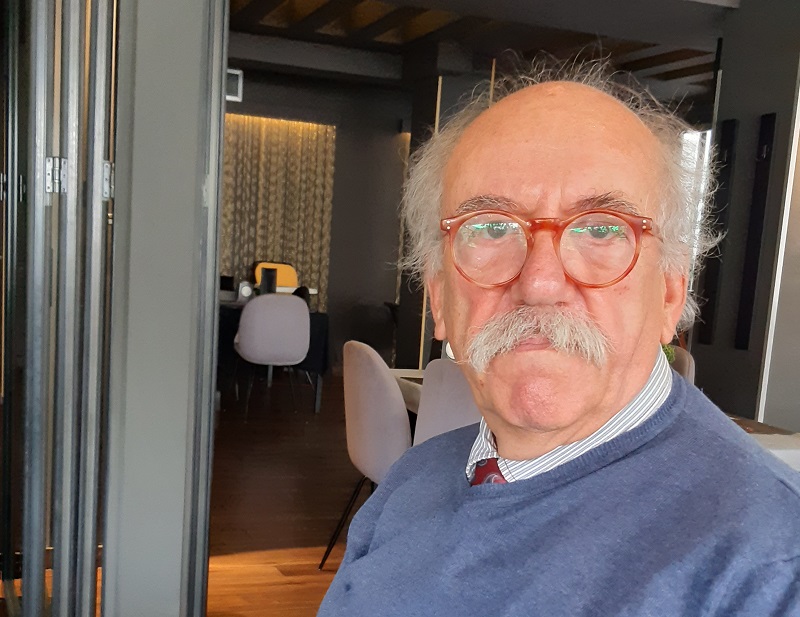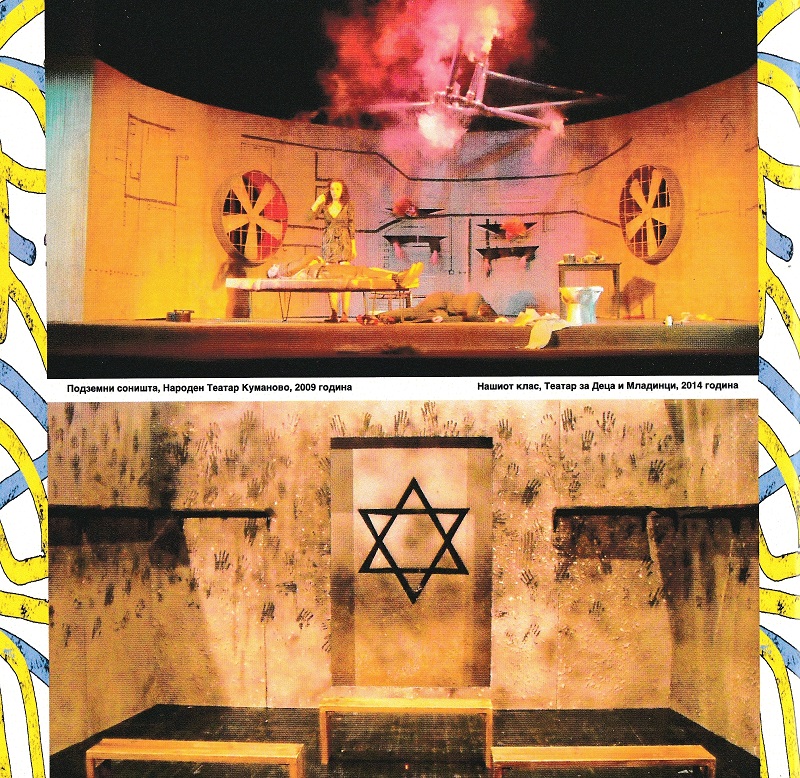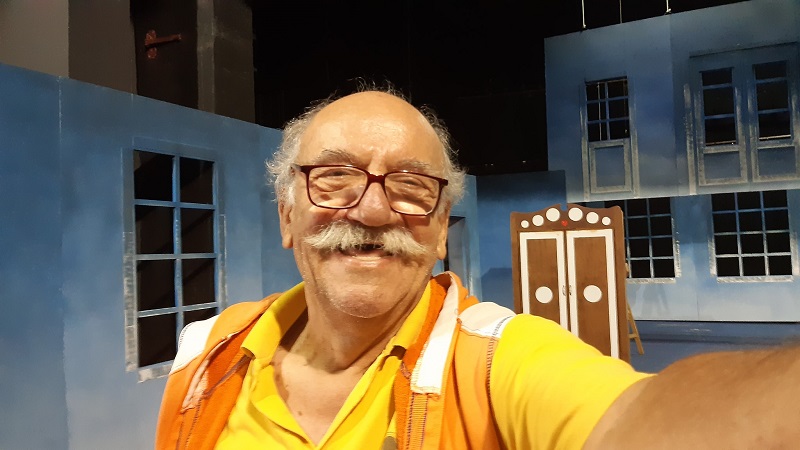Interview with Krste S. Dzidrov - Pocket: I was a call set designer all my working life

The architect Krste S. In his life, Dzidrov was engaged in many professions, but he was the most consistent and most attached to the theater, creating more than 160 sets for theatrical performances, for which he received an award for lifetime achievement.
We have two current occasions for a conversation with the theater and film set designer Krste S. Dzidrov - Pocket, and they are receiving the Lifetime Achievement Award at the 55th MTF "Vojdan Chernodrinski", which took place from 1 to 8 October in Prilep, and the preparation of the scenography for the new play "The Cherry Orchard" directed by Vladimir Milcin in The Turkish Theater in Skopje.
Meetings with Pocket are always lively and dynamic, and so it was in this case.
Each award means, but what does the award for lifetime achievement mean, especially received at the only Macedonian Theater Festival in Prilep?
- It is a great honor to receive the Lifetime Achievement Award, which this year was given to me by the Assembly of the Macedonian Theater Festival "Vojdan Chernodrinski", which is a recognition of my 40 years of professional scenography. I am especially fond of it, because this is an award from the guild, from the people - colleagues who deal with the theater and know my scenographic opus, which counts approximately 160 realized performances in all professional theaters and informal groups in Macedonia and abroad. I have been active in the theater since 1970, when I started as an actor in the avant-garde theater "Theater at St. Nikita Goltarot", and continued in the "Theater Workshop FF" and the Children's Theater Center (CTC, Cinema "Napredok") in Skopje.
All my working life I was a set designer on call. By the way, I was constantly employed in JSC "Alumina", where I had a successful career as an architect-designer. My work on the scenography is a consequence of the trust of the director Vladimir Milcin, who gave me the opportunity for my first engagement in a professional theater in 1983, in the Albanian drama at the then Theater of Nationalities in Skopje for the play "Bundle" by Edward Bond. With that performance at the Festival in Prilep I won the first prize for scenography (I worked on the scenography together with Simon Uzunovski). This was followed by five other first prizes at this festival. That is why I express my gratitude for the latest award and the great attention to my work!

Making scenography for a play is such an activity that starts from a sketch, and with the help of many other technical professions reaches a final performance. What type of human character is needed to successfully engage in this activity?
- First and foremost for the one who deals with scenography is the love for the theater. The scenographer should be creative and his own with a wide range of knowledge and information from art, especially from theater, painting, fashion… Regardless of formal education, he must be well educated to know the theater, its history, technology of making the play, various skills in the realization of scenographic elements in the workshops and to have technical knowledge. Idea and creativity are most important for success!

What is the most important thing to know before approaching a new theater project with the task of preparing a scenography for it and how much of that knowledge is architectural and how much is theatrical?
- Visiting every theater is a new experience. Every work of scenography for a new play is a new beginning, getting to know the director, the needs of the text, conquering the stage, getting acquainted with the habits of the theater collaborators in the theater where the work is done and so on. The space I make for each play has its own specificity due to the requirements of the text and the concept of the director. For the realization of the scenography it is necessary to get enough information about the work and then an upgrade is required in terms of reading and seeing things that inspire in order to get the best possible product. The theatrical is, of course, the most important, and the architectural is only, in a way, a physical realization of the idea.
You have worked on 160 plays in 33 theaters with 44 directors in a dozen countries, and you have won numerous awards. Which of all this is the strongest in your memory?
- The number of realized scenographies in various theaters and with different directors does not allow you the comfort of self-satisfaction and work according to a template. I always remember the well-done and successfully completed plays that the audience loves and that stay on the repertoire for a long time. I will especially single out the two hit plays of the Drama Theater in Skopje - "Whose are you" and "Sin or Spritzer", both directed by Dimitar Stankoski, which were repeated over 100 times in front of a crowded hall. I still remember many performances at festivals and various guest appearances. I am especially impressed by the performances of the MTF "Vojdan Chernodrinski" in Prilep, the Sterion Theater in Novi Sad, MESS in Sarajevo, the Festival in Dubrovnik, Croatia, the Biennale in Bonn, Germany, the Ibsen Festival in his hometown of Skien in Norwalk, Norway Bator, Mongolia, the festival in Cairo, Egypt and others.

Have you ever received instructions from the theater or the director to keep the scenery within budget, or to be more practical so that the play can more easily travel to other stages?
- Yes, lately these instructions for, conditionally speaking, saving and paying attention to the budget of the play have become more frequent. In exceptional cases, one should pay attention to the funds spent, because it is money approved by the Ministry of Culture and is often less than required by the bill of quantities and calculation of materials and performance for the scenography, which in addition to sketches and project I submit as part the budget for the play. It sometimes happens that the theater "saves" the part of the funds received for the realization of the plays by creating a reserve fund so that it can realize something else, for example, equipment for another play that is not part of the MK budget, or procurement of some things. for which there are no funds! Nevertheless, I always try my best not to reduce the quality of what I have predicted for the realization of the scenography.
Personally, I am fascinated by some childhood memories of the play "The Green Goose", and you were previously part of the "Theater at St. Nikita Goltarot". What did it mean to do theater at that time?
- To do theater at that time was to have a different attitude from the others, to be rebellious, avant-garde and "in". It was the time of the Beatles and the Rolling Stones, the hippie movement, the student riots in Paris, the sexual revolution, another state of new ideas and the emergence of new people. The dream of many theatergoers is to have their own theater and to be free from the conventionalities that must sometimes be observed in professional theaters. The product of this was the formation of the "Theater at St. Nikita Goltarot" in 1970, which had the motto of Lope de Vega "Theater for me is if you have two actors, four planks and one passion." Influenced by the world avant-garde theater groups, "Brad and Papet", "La Mama", then the young and promising directors Vladimir Milcin, Slobodan Unkovski, the organizer Martin Pancevski and some other like-minded people wrote "Project for a theater" and the work started. Skopje received an avant-garde cult theater that spread its fame throughout the former Yugoslavia.
As a consequence of the "Swallows" ten years later in the Aesthetic Laboratory of FF some of the former "swallows" begin to produce new aesthetics with the trademark of the "Theater Workshop FF" play "Green Goose", which was a joy for adults because of the satire and engaged humor in it and also joy for young people and children, because in its form it was something that resembles a fair theater, always mobile and with the opportunity to play in any space, indoors and outdoors.
I realized my biggest dream by building / renovating the former cinema "Napredok" in the Old Skopje Bazaar, when the informal Children's Theater Center got it in use. After receiving donations from NGOs for a project I made, its renovation began and in that area from 2002 to 2020 were realized over 40 plays for children and youth, as well as various other cultural events. I am glad that I was part of all these groups of theaters that contributed to the spread of the disease called theater.

You also did the scenography for "The Cherry Orchard" in another theater. There are many plays by the director Vladimir Milcin in which you collaborated on the scenography. What is the same and what is different in the latest scenography for the play in the Turkish Theater?
- To make a play by Chekhov is an exciting thing that requires special engagement, because his plays are always relevant at the time when they are staged and are a challenge for work. The scenographic solution in Chekhov's plays also depends on the director's conception, especially which situation is emphasized, which aspect of the drama will be emphasized. The scenography for "The Cherry Orchard", which premiered at the NI Turkish Theater in Skopje on October 1, directed by Vladimir Milcin, is second to me in this text. I worked on the first one at the Bitola Theater in 1988 with the director from Croatia Zlatko Sviben. The two scenographies are conceptually completely different, because in Bitola it was decided on the principle of a children's picture book where the pages open like in a book with glass walls behind which the cherry trees can be seen and the furniture was stylish with an idea to show the time the play was written. less romantic approach.
Unlike the scenography in Bitola, the procedure for the "cherry" in the Turkish Theater in Skopje is completely different in its solution. The director Milcin pointed out to me that "The Cherry Orchard" was a problem for the directors, because this drama has a dual nature and often insisting on the tragic, they fell into sentimentality (this is also stated in the program for the play). And that he sees it as a drama about the transition, about the unbearable lightness of the decline of humanity and civilization. That is why the scenery is "clean" and simple, without decorating the space. Only frames of the rooms in which it is played are given and by moving the backdrops the spaces of the children's room, the field, the billiard room where the waltz is played and the view of the garden are opened. The shift in this scenery is the color of the backdrops, where the blue color that loses its luster dominates!
It is called scenography in theater, but production design is often used in film. What is the difference between the preparation of theatrical and film scenography?
- The difference in the preparation of theatrical and film scenography is incomparable. The theatrical performance usually takes place in a given space-stage, a box with three walls and the fourth open wall is towards the audience. That space has certain dimensions where the stage technique is installed, chigi, rotation, spotlights, and in that space the appropriate scenography is set, which shapes the space in which the actors play the play. Support for the scenography is the light, which is specially prepared for the play. The scenography according to the design of the scenographer, according to the work to be performed, can be realized in various artistic or architectural expressions and forms where it is visible that materials that play the role of the original are used.
Unlike the theatrical, film scenography is a real world, architectural and spatial, in which everything is true and therefore locations and objects are selected that exist in accordance with the script according to which the film is shot. The scenographer determines the scenographic framework from an aesthetic and applied aspect guided by the script. The preparation for the film scenography is long-term and involves checking all selected locations, facilities and interiors with so-called "scouting" on the spot, where the set designer together with the director, cinematographer and other members of the film crew decide and define. At the same time, the scenographic team has several departments in which specialists for interior, exterior, props, etc. work. If it is necessary to build an object or space for shooting individual scenes, everything should be ideally performed without improvisations, and objects performed in a "movie city" can be used or the performed object can be placed and recorded in a studio. From this we can conclude why the term production design is also used for the scenography of a film. The difference between these two scenarios is in the viewer's optics. In the theater, the viewer always has an insight into what is on the stage and his gaze does not have to be focused on the action, while in the film the viewer sees the frame imposed by the camera.
Not only have you worked in film scenery, but you have also appeared in a film role. Among the last ones where you acted is "Willow" by Milcho Manchevski. How do they appear and what do such exits from the profession mean to you?
- Ah, I do not think it is a way out of the profession, because all the time working on a theater play or film actors, ie. the actors are here around me and they are the most important element in both cases. My appearance in some films is not very accidental, if we know that for a while I was a member of the Children's Radio Drama on Radio Skopje (1961-63), and in the "Theater at St. Nikita Goltarot" I was one of the actors. This information probably speaks of a secret desire to act, appear on stage or in a movie.
My first film experience as an actor was in Darko Mitrevski's film "Devil in the Heart" from the trilogy "Light Gray", where I accidentally entered to play the role of a preacher "Hare Krishna", in the place of someone who did not appear on set. My other role was "Bad Father" in Vardan Tozija's "Northern Flight" when Vardan, to whom I was teaching Film Scenography at the FDA, asked me - "Professor, would you like to appear in my short student film"…
I experienced the offer to play an episodic role in the movie "Willow" by Milcho Manchevski as a great honor and I accepted it without thinking. I think I justified her trust, because I received an invitation to be part of the cast in Milcho's new film, "Kajmak". I also had a small episodic role in the movie "Homo" by Igor Ivanov Izi. These "outings" outside the profession are something that gives me little pleasure entering a world that is different from what I do.
(The interview was published in "Cultural Press" No. 100, in the print edition of the newspaper "Free Press" on October 9-11, 2021)


